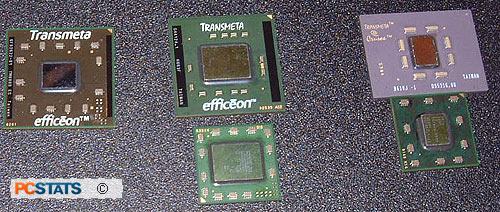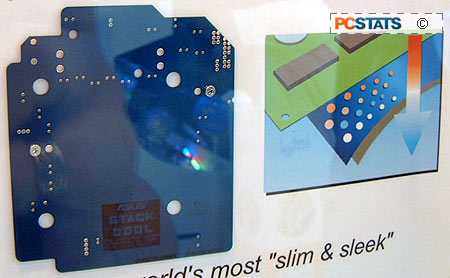|
Computex 2004 - Tech
Tidbits
Computex has always been useful event for companies to gauge the interest of
buyers in their new and innovative products. As such, during Computex 2004
countless manufacturers had mock-ups and prototypes on display. Across the
board, the home media PC appeared to generate the most interest, with products
ranging from set top boxes by Gigabyte, to the just announced TM8800 1.6GHz
Transmeta Efficeon processor powering a WindowsXP Media Center Edition system.
Transmeta burst on the
scene in 2001 with the Crusoe processor - a low voltage mobile CPU that followed
significant hype surrounding the company. Transmeta Corp. has since seen a slew
of notebooks come, and go, and are currently promoting their next generation
TM8000 Astro series CPU. PCstats met with Greg Rose, Director of Marketing for
Transmeta, and had a first hand look at the new 90-nanometer (0.09 micron) based
processor.
The new TM8800 Efficeon CPU operates at 1.6GHz (scaling from 533MHz - 1.6GHz
with Long Run 2 enabled), and is currently sampling to customers. The processor
was shown operating on three different prototype platforms, but has not yet made
it into any notebooks for the retail channel. The TM8800 CPU is shown below, at
left.
 In addition to this announcement, with the release of
WindowsXP Service pack 2, Transmeta's Anti-Virus technology will also help
protect PC's from buffer-overrun based viri. This feature will be enabled in the
next version of CMS.
 Motherboards that Cool Themselves? Motherboards that Cool Themselves?
With the advent of an industry wide push for silent
computing, significant efforts are being made to get rid of that annoying white
noise which leaks out of our PC's and Home Theatre systems.
Thermal solution companies such as Zalman
have made a name for themselves already by providing low noise, and silent
cooling systems, and now motherboard manufacturers are getting into the game.
It may seem a little odd for motherboard manufacturers to be pushing for more
low noise products, especially since most motherboards are by default entirely
silent. Yet, as new chipsets and higher processor power requirements are
introduced, silently cooling components on a motherboard is becoming a serious
issue; even more so for companies building products for the enthusiast and
overclocking markets.
Components which were once cooled by tiny passive heatsinks, like the
Northbridge, Southbridge, or power MOSFETs, are now running hot enough to
require active cooling. Overclocking only increases the thermal demands imposed.
Two motherboard manufacturers at Computex 2004 demonstrated fairly innovative
ways of passively cooling board level components; Gigabyte adopted a copper
heatpipe and cooling fins, and ASUS introduced what it calls the "Stack Cool."

Gigabyte's solution is by far the most conventional, so
we'll have a look at what ASUS has developed first. PCstats spoke with Mr. Teng,
PR manager for ASUSTeK Computer Inc., about the new Stack Cool system, which is
essentially a small 5" x 6" section of PCB soldered to the base of the
motherboard right below the processor socket, and power MOSFETs. The purpose of
this small section of PCB is to conduct heat away from the power circuitry
components, and by increasing the PCB surface area which is warmed, net a small
convection cooling factor.
|
|
|
|

